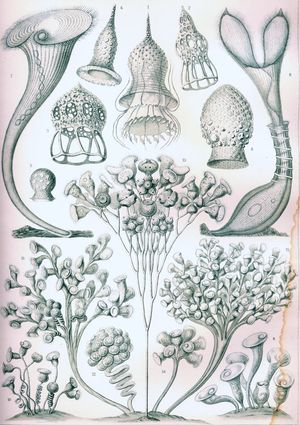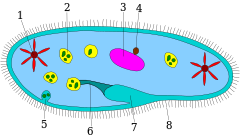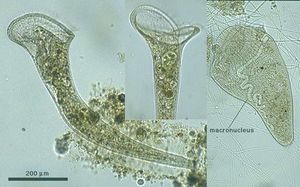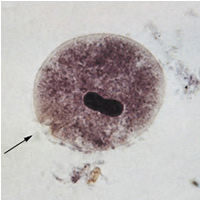سوطيات
| سوطيات Ciliates | |
|---|---|

| |
| "Ciliata" from Ernst Haeckel's Kunstformen der Natur, 1904 | |
| التصنيف العلمي | |
| Domain: | |
| مملكة: | |
| Superphylum: | |
| Phylum: | سوطيات Doflein, 1901 emend.
|
| Classes | |
|
Karyorelictea | |
السوطيات هي مجموعة من الحيوانات الأولية ختلف أجناسها وأنواعها اختلافا كبيرا في التركيب والعادات، ولكنها تتفق في صفة مشاركة وهي وجود سوط أو أكثر لكل فرد. ويشبه الكثير منها النباتات في طريقة التغذية ويشبه بعضها السركودينا كما يشبه بعضها الخلايا المطوقة في الاسفنج.
The term "Ciliophora" is used in classification as a phylum.[1] Ciliophora can be classified under Protista[2] or Protozoa.[3] The term "Ciliata" is also used,[4] as a class.[5] (However, this latter term can also refer to a type of fish.) Protista classification is rapidly evolving, and it is not rare to encounter these terms used to describe other hierarchical levels.
Ciliates are one of the most important groups of protists, common almost everywhere there is water — in lakes, ponds, oceans, rivers, and soils. Ciliates have many ectosymbiotic and endosymbiotic members, as well as some obligate and opportunistic parasites. Ciliates tend to be large protozoa, a few reach 2 mm in length, and are some of the most complex protozoans in structure.
. . . . . . . . . . . . . . . . . . . . . . . . . . . . . . . . . . . . . . . . . . . . . . . . . . . . . . . . . . . . . . . . . . . . . . . . . . . . . . . . . . . . . . . . . . . . . . . . . . . . . . . . . . . . . . . . . . . . . . . . . . . . . . . . . . . . . . . . . . . . . . . . . . . . . . . . . . . . . . . . . . . . . . . .
تركيب الخلية

Unlike other eukaryotes, ciliates have two different sorts of nuclei: a small, diploid micronucleus (reproduction), and a large, polyploid macronucleus (general cell regulation). The latter is generated from the micronucleus by amplification of the genome and heavy editing. Division of the macronucleus occurs by amitosis, the segregation of the chromosomes is by a process whose mechanism is unknown. This process is by no means perfect, and after about 200 generations the cell shows signs of aging. Periodically the macronuclei must be regenerated from the micronuclei. In most, this occurs during conjugation. Here two cells line up, the micronuclei undergo meiosis, some of the haploid daughters are exchanged and then fuse to form new micronuclei and macronuclei.
Food vacuoles are formed through phagocytosis and typically follow a particular path through the cell as their contents are digested and broken down via lysosomes so the substances the vacuole contains are then small enough to diffuse through the membrane of the food vacuole into the cell. Anything left in the food vacuole by the time it reaches the cytoproct (anus) is discharged via exocytosis. Most ciliates also have one or more prominent contractile vacuoles, which collect water and expel it from the cell to maintain osmotic pressure, or in some function to maintain ionic balance. These often have a distinctive star-shape, with each point being a collecting tube.
التغذية
تتغذى معظم السوطيات على كائنات أصغر (متنوعة الغذاء)، مثل البكتريات والطحالب، and detritus swept into the oral groove (mouth) by modified oral cilia. This usually includes a series of membranelles to the left of the mouth and a paroral membrane to its right, both of which arise from polykinetids, groups of many cilia together with associated structures. The food is moved by the cilia through the mouth pore into the gullet, which forms food vacuoles.
This varies considerably, however. Some ciliates are mouthless and feed by absorption, while others are predatory and feed on other protozoa and in particular on other ciliates. This includes the suctoria, which feed through several specialized tentacles.
التكاثر
تتكاثر السوطيات عن طريق التكاثر الجنسي والتكاثر اللاجنسي. ويتم التكاثر اللاجنسي عن طريق الانقسام الثنائي.
The micronucleus undergoes by mitosis and the macronucleus elongates and splits in half. Both new cells each obtain a copy of the micronucleus and macronucleus. Sexual reproduction involves conjugation, which involve two cells. After conjugation, the two cells divide, forming four new cells.
الهياكل المتخصصة
In some forms there are also body polykinetids, for instance, among the spirotrichs where they generally form bristles called cirri. More often body cilia are arranged in mono- and dikinetids, which respectively include one and two kinetosomes (basal bodies), each of which may support a cilium. These are arranged into rows called kineties, which run from the anterior to posterior of the cell. The body and oral kinetids make up the infraciliature, an organization unique to the ciliates and important in their classification, and include various fibrils and microtubules involved in coordinating the cilia.
The infraciliature is one of the main component of the cell cortex. Another are the alveoli, small vesicles under the cell membrane that are packed against it to form a pellicle maintaining the cell's shape, which varies from flexible and contractile to rigid. Numerous mitochondria and extrusomes are also generally present. The presence of alveoli, the structure of the cilia, the form of mitosis and various other details indicate a close relationship between the ciliates, Apicomplexa, and dinoflagellates. These superficially dissimilar groups make up the alveolates.
السجل الأحفوري
Until recently, the oldest ciliate fossils known were tintinnids from the Ordovician Period. In 2007, Li et al. published a description of fossil ciliates from the Doushantuo Formation, about 580 million years ago, in the Ediacaran Period. These included two types of tintinnids and a possible ancestral suctorian. [6]
التصنيف
Subphylum Postciliodesmatophora
- Class Karyorelictea
- Class Heterotrichea (e.g. Stentor)
Subphylum Intramacronucleata
- Class Spirotrichea
- Subclass Choreotrichia (e.g. Tintinnidium)
- Subclass Oligotrichia (e.g. Halteria)
- Subclass Stichotrichia (e.g. Stylonychia)
- Subclass Hypotrichia (e.g. Euplotes)
- Class Litostomatea
- Subclass Haptoria (e.g. Didinium)
- Subclass Trichostomatia (e.g. Balantidium)
- Class Phyllopharyngea
- Subclass Phyllopharyngia
- Subclass Rhynchodia
- Subclass Chonotrichia
- Subclass Suctoria (e.g. Podophrya)
- Class Nassophorea
- Class Colpodea (e.g. Colpoda)
- Class Prostomatea (e.g. Coleps)
- Class Oligohymenophorea
- Subclass Peniculia (e.g. Paramecium)
- Subclass Hymenostomatia (e.g. Tetrahymena)
- Subclass Scuticociliatia
- Subclass Peritrichia (e.g. Vorticella)
- Subclass Astromatia
- Subclass Apostomatia
- Class Plagiopylea
أخرى
- Genus Cryptocaryon
المصادر
- ^ "Ciliophora - Definition from Merriam-Webster's Medical Dictionary". Retrieved 2009-01-16.
- ^ Yi Z, Song W, Clamp JC, Chen Z, Gao S, Zhang Q (2008). are protistainkinghub.elsevier.com/retrieve/pii/S1055-7903(08)00581-2 "Reconsideration of systematic relationships within the order Euplotida (Protista, Ciliophora) using new sequences of the gene coding for small-subunit rRNA and testing the use of combined data sets to construct phylogenies of the Diophrys-complex". Mol. Phylogenet. Evol. doi:10.1016/j.ympev.2008.12.006. PMID 19121402.
{{cite journal}}: Check|url=value (help); Unknown parameter|month=ignored (help)CS1 maint: multiple names: authors list (link) - ^ Miao M, Song W, Chen Z; et al. (2007). "A unique euplotid ciliate, Gastrocirrhus (Protozoa, Ciliophora): assessment of its phylogenetic position inferred from the small subunit rRNA gene sequence". J. Eukaryot. Microbiol. 54 (4): 371–8. doi:10.1111/j.1550-7408.2007.00271.x. PMID 17669163.
{{cite journal}}: Explicit use of et al. in:|author=(help)CS1 maint: multiple names: authors list (link) - ^ "Introduction to the Ciliata". Retrieved 2009-01-16.
- ^ "Ciliata - Definition from Merriam-Webster's Medical Dictionary". Retrieved 2009-01-16.
- ^
Li, C.-W. (2007). "Ciliated protozoans from the Precambrian Doushantuo Formation, Wengan, South China". Geological Society, London, Special Publications. 286: 151–156. doi:10.1144/SP286.11.
{{cite journal}}: Unknown parameter|coauthors=ignored (|author=suggested) (help)
محمود, عبد العزيز (2008). اللافقاريات. القاهرة، مصر: مكتبة الأنجلو المصرية. {{cite book}}: Unknown parameter |coauthors= ignored (|author= suggested) (help)



